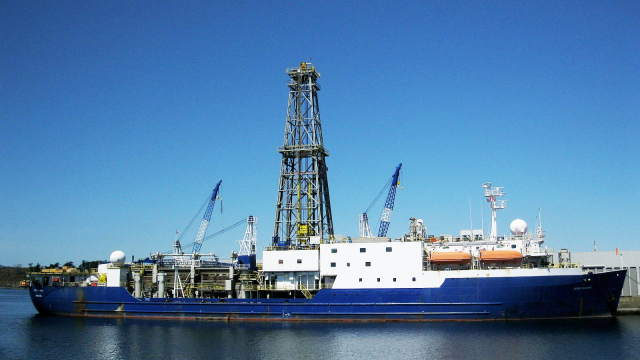You won’t see many living things above the ocean surface hundreds of miles southeast of Madagascar—an albatross or the occasional fishing vessel may break up the hours of solitude. But beneath the surface, lava from Earth’s mantle has uplifted a long, underwater mountain range with a flat top extending 5 kilometres above the seafloor. Its name, the Atlantis Bank, is oddly appropriate; here, microbial communities have somehow found a way to thrive, deep in Earth’s lower crust.
Scientists onboard the JOIDES Resolution research vessel visited the unique geology as a part of Expedition 360 of the International Ocean Discovery Program (IODP). They drilled 809 meters into the crust, revealing new insights into the kinds of organisms that can survive in Earth’s most remote locations.
“There is a community down there,” Virginia Edgcombe, the study’s corresponding author and associate scientist at the Woods Hole Oceanographic Institute, told Gizmodo. It’s a slow-growing, low-biomass community, but it’s there. “That’s exciting because it extends our view of the habitable biosphere on Earth and just indicates that in the lower crust it’s possible for life to exist.”
Past research has already revealed that microorganisms live deep into the upper crust, but there’s less information about what thrives in the lower crust. The Atlantis Bank provides a unique insight into this region; there, tectonic activity has uncovered a large chunk of the lower crust around 700 meters below sea level. Scientists on the expedition drilled down into the crust, pulling up cores 10 meters at a time, which they analysed both on the boat and back in the lab. This area is among the closest drills have ever come to Earth’s mantle.
The researchers had to be sure that no contaminants got into their samples. They included a chemical tracer in the drilling fluid, then peeled away the outer layers of the core that had obviously been contaminated. If any tracer remained in a sample, they could discard it. They also analysed the samples in sterile environments, which contained nutrient-rich petri dishes that would have sprouted with invading life had there been any outside contaminants in the room.
The team published their results in Nature last week.
A host of experiments analysed the core samples for DNA and RNA, fat molecules, and other life-supporting materials. The core revealed the signatures of sparsely populated but present and active microbial life, including relatives of the same kinds of organisms that live on deep sea vents and even fungi that feast on the dead. These organisms weren’t making their own food—they were surviving on carbon molecules that somehow permeated into the deep fissures in the crust from seawater that leaked in.
Jennifer Biddle, associate professor at the University of Delaware who was not involved in the study but who reviewed the paper, thought it was exciting that life could still exist at this location, so deep into Earth and so close to the mantle. She was convinced that this deep-crust life really did exist thanks to the variety of different tests that all pointed toward the presence of this microbial community.
“It shows that microbes are everywhere,” Biddle told Gizmodo. “You don’t expect rock to have any life in it. But there are these tiny fractures that have just enough activity to keep things going. That’s amazing to think about—there’s so much life on Earth that it’s getting into every crevice it can possibly fit in.”
These findings are bittersweet for those hoping similar life might exist on other planets. Yes, these microbes are surviving the extreme—but they still participate in the global nutrient cycles that provide the food that keeps them alive, rather than being isolated individuals surviving without any external inputs.
But here on Earth, at least, the study bolsters the cliche from Jurassic Park: “Life, uh, finds a way.”
